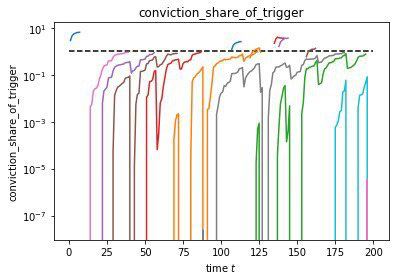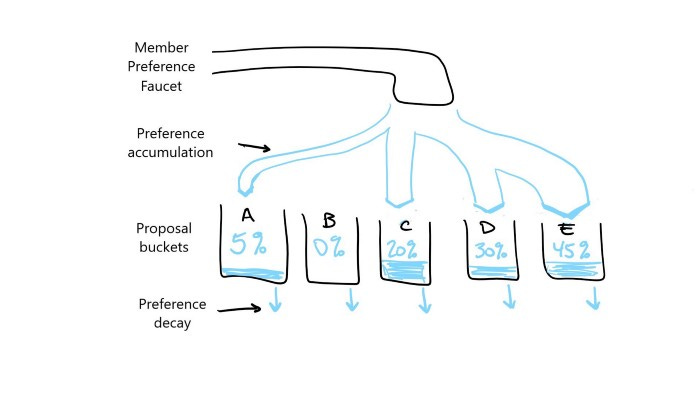DAOs and Democracy: Voting Mechanisms in Web3 🗳️🏛️
Exploring the voting mechanism design space for DAO governance
Table of Contents 🕹️
Introduction 🐙
Token-Based Quorum Voting 🖋️
Liquid Democracy 📚
Holographic Consensus 🎲
Quadratic Voting 📈
Conviction Voting ⚖️
Exploring the Design Space 🏛️
Further Down the Rabbit Hole 🕳️
Writing laws is easy, but governing is difficult.
― Leo Tolstoy, War and Peace
This issue is sponsored by…
Tally empowers voters to successfully participate in on-chain governance via a sophisticated voting dashboard. Users are able to see current and past proposals, cast votes, delegate voting power, and analyze governance trends across multiple DAOs. Tally currently supports some of the largest DAOs in the space, including Uniswap, PoolTogether, Gitcoin, Compound, Radicle, and more.
Unlock the knowledge you need to level up your Web3 citizenship by using the Tally dashboard today…
I. Introduction 👾
How do we make collective decisions?
Most nation-states, voluntary organizations, economic firms, and other collectives have defaulted to democracy as the most ideal form of collective decision-making. A democracy can be characterized as a governance model in which participants are given equality at some essential point in the decision-making process.
The philosophical justification for democracy typically rests on the foundation of instrumentalism. Democracy is believed to be a more responsive form of governance that empowers autonomous voters while simultaneously tending toward outcomes in line with what would be independently viewed as ‘correct’. John Stuart Mill, for example, argued that democracy, in giving a proportionate share of voting power to each subject, forces decision-makers to account for the rights and interests of a wider range of the population when compared with oligarchies or aristocracies. This forces political outcomes to more closely reflect the will of the governed, and assuming voters are competent, sincere, and independent, one would expect the most ideal outcomes to prevail.
But while some have proclaimed the dawn of democracy as the end of history, there is a darker truth remaining: democracies still have a host of problems to solve. Namely, we must overcome paradoxes in voting outcomes versus voter preferences, low voter engagement or lack of specialization/knowledge, and efficiency (especially when considering decentralized structures).
The most vexing of these issues is to determine whether the general population of voters are up to the task of appropriately governing a collective. Plato notoriously declared democracies inefficient since they undermine the expertise necessary to properly govern a society. Most people are not endowed with the wherewithal to understand the complexities of governance issues if they are not specialists in the particular field or deeply involved in the day-to-day management of the organization. Plato called for a rule by philosopher-kings, a form of epistocracy reminiscent of an expert-run oligarchy.
Decentralized autonomous organizations have typically developed with democracy as a core tenet of their governance processes. Token holders are able to express their opinion on proposals that govern the DAO by “voting their shares”. However, governance is tricky: voter engagement is typically low, one-token-one-vote systems tend toward plutocracies, and the knowledge needed by any one voter to effectively select optimal outcomes requires specialization, especially as the DAO grows in size to the point where it is no longer feasible to know what every working group is up to.
There are two major considerations a DAO governance model must balance when selecting a voting methodology:
Scale - The ability of a governance system to process a large number of decisions in a given period, increasing in rate as the DAO scales in network size.
Resilience - The ability of a governance system to resist nefarious, poorly considered, fraudulent, or otherwise unintended governance decisions.
In any decentralized system, there is a constant tension between resilience and scalability. Resiliency demands that decisions be delegated to the wider community to ensure a small minority can not gain complete control of the DAO. However, this means a constant flow of proposals that slow down the effectiveness of a DAO, hindering its scalability.
This issue will explore some of the ways in which DAOs are innovating to properly account for these difficulties. We will briefly explore the current status quo of token-based quorum voting, along with some innovative extensions of the democratic model in the Web3 era: liquid democracy, holographic consensus, quadratic voting, and conviction voting.
II. Token-Based Quorum Voting 👾
Quorum voting is a voting method where a certain threshold of voters is required for a proposal to pass. As long as the threshold is met, either decision may win. However, if the proposal does not reach quorum, then it is automatically rejected. To illustrate how this works, imagine there are 100,000 tokens in circulating supply with voting rights. A DAO could elect to require a 60% quorum for a proposal to pass, meaning 60,000 tokens must vote on the proposal. If 55% vote ‘yes’ and 45% vote ‘no’, the proposal will pass as long as the combined total of ‘yes’ and ‘no’ votes is greater than or equal to 60,000.
Token-based quorum voting is the most common method of voting for DAOs. It has a long history in political philosophy since it is effectively a form of direct democracy where one token equals one vote. Given the relationship between the value of a token and the outcome of governance proposals, it is believed that a rational economic agent would vote in a way conducive to their economic best interests, which would theoretically align with the economic best interests of the entire DAO.
Quorum voting has been criticized for effectively delegating voting power to wealthy investors. Since votes can be purchased, this methodology can ultimately lead to the formation of plutocracies. On top of that, passing a proposal becomes political in nature as a large amount of time is spent campaigning to ensure quorum is met.
In addition, token-based quorum voting requires a large amount of participation by the community to pass proposals. This may be suitable for DAOs with simple mandates and relatively few proposals, but as complexity scales, it becomes increasingly time-consuming for the average community member to vote on every proposal to meet quorum, and outright impossible at a certain scale. This can result in even widely accepted, non-controversial proposals being rejected due to a failure to reach quorum. It also leads to voters casting votes on proposals they don’t fully understand, which lowers the total resiliency of the DAO.
III. Liquid Democracy 👾
Liquid democracy is a form of delegative democracy whereby an electorate engages in collective decision-making through direct participation and dynamic representation. Voters can participate directly on all issues or elect to delegate their votes to a representative. Any individual is able to delegate votes, including representatives in what is known as metadelegation.
Charles Dodgson (pseudonymously known as Lewis Carroll), the author of Alice in Wonderland, first proposed a liquid voting model in The Principles of Parliamentary Representation in 1884. In this pamphlet, he envisioned a system where every voter could either cast their own vote or transfer it to another.
According to Bryan Ford in his paper Delegative Democracy, liquid democracy is built on the following principles:
Choice of Role: Each member can choose to take either a passive role as an individual, or an active role as a delegate. Delegates have further choices as to how active they are and in what areas.
Low Barrier to Participation: The difficulty and cost of becoming a delegate is small, and in particular does not require campaigning or winning a competitive election.
Delegated Authority: Delegates exercise power in organizational processes on behalf of themselves and those who vote for them. Different delegates exercise varying levels of decision power.
Privacy of Individuals: To avoid social pressures or coercion, all votes made by individuals are private, both from other individuals and from delegates.
Accountability of Delegates: To ensure accountability of delegates to their voters and to the community at large, all formal deliberative decisions made by delegates are public.
Specialization by Re-Delegation: Delegates can not only act directly on behalf of individuals as generalists, but through re-delegation they can also act on behalf of other specialists.
The primary considerations when operating within a liquid democracy framework includes:
Meritocracy: Delegation of votes in a liquid democracy tends to shift toward specialists with necessary experience or knowledge. A study by Caragiannis and Evi Micha found that in instances where less informed citizens delegated to specialists, there was less discovery of “ground truth”—instead, if every voter had voted directly (or if all votes were delegated to a supreme leader), the “ground truth” is more likely to be found.
Oligarchic Tendencies: Similar to electoral political systems, liquid democracy could result in a concentration of power into the hands of the socially prominent, the wealthy, and/or political strategists resulting in voting power inequity.
Scale: As the electorate grows, so too does the amount of delegates. Deliberation breaks down at a certain point, resulting in a necessary fracturing into groups.
Gitcoin successfully implemented liquid democracy at the initiation of the DAO by having token holders select a delegate as part of the airdrop claim process. You can read more about it in our issue on Gitcoin here.
IV. Holographic Consensus 👾
Holographic Consensus was a voting mechanism created by DAOstack that combines futarchy, or prediction markets, with token-based quorum voting. In the Holographic Consensus model, predictors can stake funds for or against a proposal they believe will pass or fail, and if they predict correctly, they are entitled to a financial incentive. If a proposal is predicted to pass, it is “boosted”, meaning it can pass with a simple relative majority rather than requiring a quorum to be met.
Holographic Consensus is a unique spin on solving the resiliency versus scalability trade-off. The most obvious answer to scaling decision-making power is to approve proposals using a relative majority rather than having a quorum threshold. Relative-majority requires only a majority of those who voted to approve or reject a proposal, rather than a threshold amount of the total voting power. However, this can lead to a nefarious actor potentially passing proposals if they could slip it under the radar of the broader community. To combat this, Holographic Consensus implements “boosting” via prediction markets.
Decisions under the Holographic Consensus model must be approved with an absolute majority by default. However, a proposal can be “boosted” from an absolute majority to a relative majority if it meets the boosting conditions. Boosting a proposal effectively gives DAOs back their scarcest resource: attention. The prediction market creates an attention economy, leading to non-controversial proposals passing with a simple relative majority and leaving the more contentious votes for the stricter absolute majority with quorum voting.
It’s important to note that a fixed boosting rate by itself won’t solve much. A fixed rate is effectively just another quorum mechanism and comes with similar flaws: too high and quorum difficulties prevail, too low and an attacker can easily boost the proposal in an attempt to attack the protocol. Implementing an exponential boosting threshold adds a layer of resilience to governance: it slows the amount of proposals up for consideration so that DAO attention remains highly focused. The cost could become prohibitive quickly though, which does lower scalability.
The prediction market for proposals should theoretically be managed by a token separate from the governance token of the DAO implementing Holographic Consensus. This will ensure impartial predictions while simultaneously freeing up the attention of the DAO in line with the stated goal of the model. Predictors should be incentivized via a payment for betting accurately. If a predictor bets incorrectly, their stake should be partially slashed. This makes governance attacks through the boosting mechanism economically disadvantageous while improving total accuracy of the market.
According to DAOstack, predictors are incentivized for:
Fishing out ‘good proposals’—predictors filter a long list of proposals for the voters to focus on. The predictors’ bounty creates an economic incentive to find out those proposals and an open market will take over that opportunity.
Signal and balance the propagation of ‘bad proposals’—once a proposal is being boosted predictors have an even higher incentive to downstake it if they think it’s not going to be approved by voters after all. Again, an economic market should saturate this arbitrage.
Finally, once predictors are staked on both sides of the future they have the incentive to maintain the voting process and its alignment with the global opinion. Those who observe a misalignment would call out the collective attention, and specifically those voters who they believe will fix it.
DXdao is the most notable example of a DAO using the Holographic Consensus mechanism.
V. Quadratic Voting 👾
Quadratic voting is a decision-making process whereby individuals allocate votes to express the degree of their preferences, rather than just the direction of their preferences. Essentially, voters can elect to pay for additional votes on a proposal to more strongly emphasize their position. The cost of each additional vote grows exponentially: cost to the voter = (number of votes)^2.
Quadratic voting is based on market principles. Voters are assigned a total voting budget and then they are free to allocate the votes as they wish. The most efficient use is to spread the votes across multiple issues; however, if the voter is passionate about a topic, they can instead elect to buy more votes on that specific outcome creating a kind of preference economy.
Quadratic voting can be done with an assigned budget of votes per unique individual, or payment for votes could occur with real currencies, such as the native DAO governance token. In the former case, democratic equality stems from a defined allocation of votes. In the latter, the exponential cost of voting helps to decrease the influence of wealth in the voting process, but it remains a valid concern. Typically, quadratic voting proponents prefer the distribution of an artificial currency for purchasing votes to minimize the development of plutocracies.
E. Glen Weyl, a Microsoft researcher, was the first to coin the term ‘quadratic voting’, extending the concept beyond an earlier iteration called the Vickery-Clarke-Groves mechanism. Weyl’s primary motivation for quadratic voting was to fight against the ‘tyranny of the majority’. In the quadratic voting model, minorities are able to purchase additional votes to help level the playing field on issues, thereby increasing total social welfare.
The concept of quadratic voting has been championed by the likes of Vitalik Buterin and Gitcoin, specifically through how the model can be applied to funding mechanisms for public goods (you can check this out in more detail in the issue we did on Gitcoin here).
The primary issue with implementing quadratic voting, however, is Sybil attacks. A Sybil Attack is where an attacker utilizes fake or duplicate identities in order to influence outcomes. Having multiple identities within a quadratic voting framework means exponentially more voting power, leading to outsized influence. Scaling proof of personhood initiatives is our greatest chance at adopting quadratic voting.
VI. Conviction Voting 👾
Conviction voting is a decision making process that selects for the aggregated preference of community members expressed continuously over time. Voters assert their preference by assigning their votes to proposals they would like to see approved. The longer a member stakes their votes on a proposal, the more conviction accrues. The community member can change which proposals their votes are staked on at any time, reflecting a change in total conviction. After enough conviction accrues, the proposal is passed.
Time has a few primary impacts on the conviction voting method and can be best understood using a buckets of water analogy developed by Commons Stack. Suppose there are five proposals as represented by buckets A, B, C, D, and E. When a voter wishes to express an opinion on a proposal, they activate their Member Preference Faucet and divert a portion of the stream to the bucket. Let’s say they allocate 5% of the flow to proposal A, 0% to B, 20% to C, 30% to D, and 45% to E. Over time, the bucket will fill in those proportions as the preference faucet runs. If the voter later decides to reallocate from one proposal to another, let’s say from 5% on A to 5% on B, the preference conviction begins to decay as if there was a hole in the bottom of the bucket A. The intent of this decay is to prevent situations where there are abrupt movements of staked tokens, eliminating the need for token lock-ups to avoid last minute vote swings.
Interestingly, the conviction voting method stems from a biomimetic approach to system design. Biomimetics is the emulation of systems within nature for the purpose of solving complex human problems. The design is understood as an analogy to how individual neurons fire within the human brain. Action potential builds up over time until an action threshold is reached and the neuron is fired.

Conviction voting’s continuous mechanism turns vote buying, a potential concern of time-boxed on-chain voting systems, into vote renting. An attacker is required to continuously expend funds over long periods of time in order to successfully influence the outcome of a vote. This drives up the resilience of the system against vote buying attacks and other forms of voting collusion. Another benefit: token holders with long-held, consistent views accumulate more conviction on a proposal, helping lower governance instability from new wealth entering into the DAO.
VII. Exploring the Design Space 👾
The voting methods above all attempt to solve the resilience versus scalability dilemma in DAO governance design. Each has its own set of challenges, such as the difficulty in educating a voter on the mechanism of Holographic Consensus or solving Sybil resistance for quadratic voting, but the exploration itself is the most important outcome. The goal should be to consistently innovate, expanding on 2,000 years of political philosophy through technological applications.
DAOs and crypto-economics enable the exploration of the voting mechanism design space on an unprecedented scale. They are a new organism, and the game theoretic mechanisms they’re built on will define their long-term survival. Their rapid pace of innovation and relative ease in formation leads to a quick succession of experiments, helping us understand how best to coordinate on humanity’s greatest challenges.
VIII. Further Down the Rabbit Hole 🕳️
Coordination, Good and Bad by Vitalik Buterin
Delegative Democracy by Bryan Ford
Quadratic Payments: A Primer by Vitalik Buterin
Holographic Consensus—Part 1 and Part 2 by DAOstack
Conviction Voting: A Novel Continuous Decision Making Alternative to Governance by Jeff Emmett
Accelerated Capital is a weekly publication exploring how cryptoassets, DeFi, virtual reality, and other exponential technologies are transforming our economy, society, and culture.
Be sure to subscribe to this newsletter below and follow us on Twitter.







